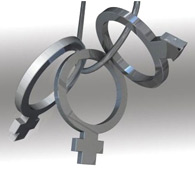Researchers from the University of Utah, who assessed 79 non-heterosexual women five times over the course of a decade, debunked the stereotype that bisexual women aren't able to commit to monogamous relationships.

By the end of the study, more than 60 percent of those who identified as bisexual in 1995 were involved in relationships lasting longer than five years - compared to about 35 percent of lesbians and 30 percent of unlabeled women.
The study also found bisexuality among women to be a distinct orientation and not a temporary stage and commonly thought as the bisexual women who were tracked remained attracted to both men and women throughout that time.
Diamond, an associate professor of psychology and gender studies, first conducted face-to-face interviews with her subjects between the ages of 18 and 25 around New York state in 1995. The women identified themselves as lesbian, bisexual or unlabeled, but not heterosexual. She then spoke with them by phone every two years.
"This is the first research that's really followed bisexual women for such a long period of time and it really, I think, puts to rest the notion that this is a transitional stage," said Diamond.
"If it was a phase, it should have burnt out. They might have a change in identity and relationships, but that pattern of non-exclusive desire is still there, even among those who have married. It debunks the notion of it being a phase."
According to the professor, most women "possess the capacity to experience sexual desires for both sexes, under the right circumstances."
Based on the results of her study, Diamond added that she expects that over time more women would have the opportunity to become aware of this capacity and may adopt bisexual/unlabeled identities rather than exclusive lesbian or heterosexual identities.
"Despite our modern day and age it's amazing how persistent some of the negative stereotypes about bisexuality have been. There are still even some researchers, as well as lay people, who are not really sure that it really exists, who have viewed it as a transitional state on the way to lesbianism, or viewed it as just something that some confused heterosexuals will claim about themselves," Diamond was quoted as saying in an interview with Reuters.
The study also supports the commonly held notion that female sexuality is relatively fluid and that the "distinction between lesbian and bisexual women is not a rigid one."
Researchers found that women's "definitions of lesbianism appeared to permit more flexibility in behaviour than their definitions of heterosexuality. In all, 76 percent of the women who switched to lesbian labels pursued sexual contact with both men and women during the two years prior to the identity change, compared with 30 percent of women who switched to heterosexual labels."
The report can be read in the January issue (vol. 44) of Developmental Psychology, a journal of the American Psychological Association.
